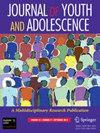中学生友谊同一性、种族/民族认同承诺与群体间偏见的发展轨迹
IF 3.6
1区 心理学
Q1 PSYCHOLOGY, DEVELOPMENTAL
引用次数: 0
摘要
虽然种族/民族同一性是友谊网络的一个共同特征,但对于青少年早期对同种族/民族友谊的偏好是如何发展的,或者它们是如何与种族/民族认同和群体间偏见(倾向于内部群体而不是外部群体的态度)的发展联系在一起的,我们知之甚少。为了解决这些差距,本研究考察了基线水平与友谊同一性(同种族/民族偏好)、种族/民族认同承诺和群体间偏见之间的纵向联系。使用一个大的种族/民族多样化样本(N = 4,576;法师= 11.33年at T1;51%的女性;41%的拉丁裔,26%的白人,17%的东亚/东南亚人,16%的非洲裔美国人/黑人)。多元潜在增长曲线模型的研究结果表明,友谊同质性和身份承诺轨迹密切相关。此外,基线同质性预测了随着时间的推移,少数种族/民族青年的身份承诺会增加,而白人青年则不会。相比之下,友谊同质性和群体间偏见之间的纵向关联很弱。基线友谊同质性不能预测群体间偏见轨迹;然而,群体间偏见的基线水平预测了种族/少数民族青年的同质性增加。研究结果表明,对于少数族裔的早期青少年,友谊同一性的发展与身份承诺的关系比群体间偏见的关系更密切。本文章由计算机程序翻译,如有差异,请以英文原文为准。
Developmental Trajectories of Friendship Homophily, Racial/Ethnic Identity Commitment, and Intergroup Bias Across Middle School.
Although racial/ethnic homophily is a common feature of friendship networks, little is known about how preferences for same-race/ethnic friendships develop during early adolescence or how they are linked to the development of racial/ethnic identity and intergroup bias (attitudes favoring ingroups over outgroups). To address these gaps, the present study examined the longitudinal associations between baseline levels and trajectories of friendship homophily (same-race/ethnic preference), racial/ethnic identity commitment, and intergroup bias among early adolescents across the middle school years. Using a large racially/ethnically diverse sample (N = 4,576; Mage = 11.33 years at T1; 51% female; 41% Latinx, 26% White, 17% East/Southeast Asian, 16% African American/Black), findings from multivariate latent growth curve models indicated that friendship homophily and identity commitment trajectories were closely linked. Additionally, baseline homophily predicted greater identity commitment over time for racial/ethnic minoritized youth, but not White youth. In contrast, longitudinal associations between friendship homophily and intergroup bias were weak. Baseline friendship homophily did not predict intergroup bias trajectories; however, baseline levels of intergroup bias predicted increased homophily for racial/ethnic minoritized youth. Findings indicated that for racial/ethnic minoritized early adolescents, the development of friendship homophily is more closely linked to identity commitment than intergroup bias.
求助全文
通过发布文献求助,成功后即可免费获取论文全文。
去求助
来源期刊

Journal of Youth and Adolescence
PSYCHOLOGY, DEVELOPMENTAL-
CiteScore
8.20
自引率
6.10%
发文量
155
期刊介绍:
Journal of Youth and Adolescence provides a single, high-level medium of communication for psychologists, psychiatrists, biologists, criminologists, educators, and researchers in many other allied disciplines who address the subject of youth and adolescence. The journal publishes quantitative analyses, theoretical papers, and comprehensive review articles. The journal especially welcomes empirically rigorous papers that take policy implications seriously. Research need not have been designed to address policy needs, but manuscripts must address implications for the manner society formally (e.g., through laws, policies or regulations) or informally (e.g., through parents, peers, and social institutions) responds to the period of youth and adolescence.
 求助内容:
求助内容: 应助结果提醒方式:
应助结果提醒方式:


